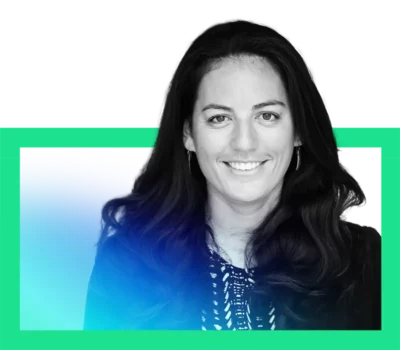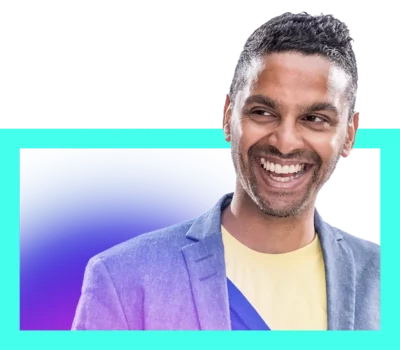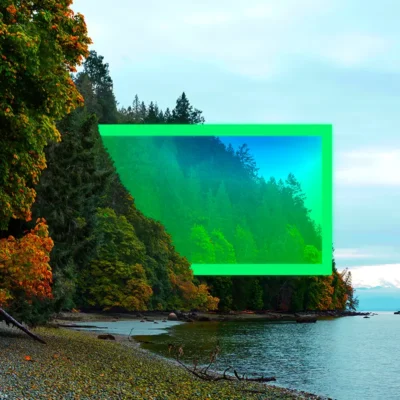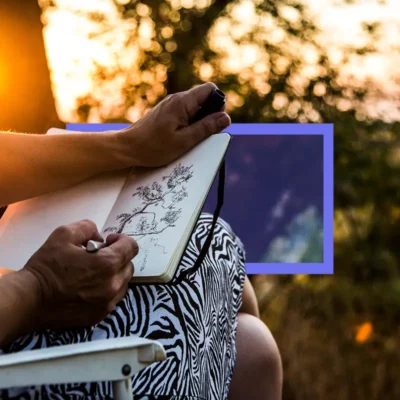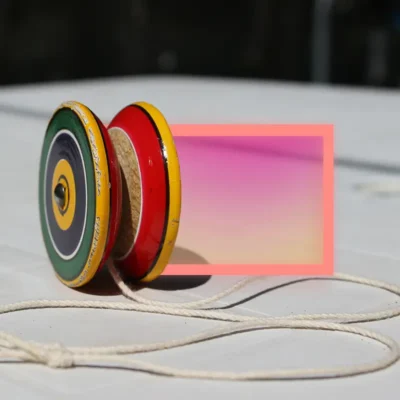Tracking the path of the sun
Lehua Kamalu captains a vast, double-hulled ocean canoe crafted to the exact specifications of the seafaring vessels used by her ancestors. She and her crew are making a 2,500 mile journey between Tahiti and Hawaii, the same one original settlers of the South Pacific traversed, the same journeys historians once struggled to believe possible without today’s technology. The stakes are high, and they sail the way their ancestors sailed, taking their cues from the water and wind. Lehua stays alert and patient hours on end. It’s only by being grounded in the signs that Lehua can anticipate the possibilities. And it’s only by staying present that Lehua can take in the magic of the open water — and draw from that magic to sustain herself when each journey ends, as they inevitably do.
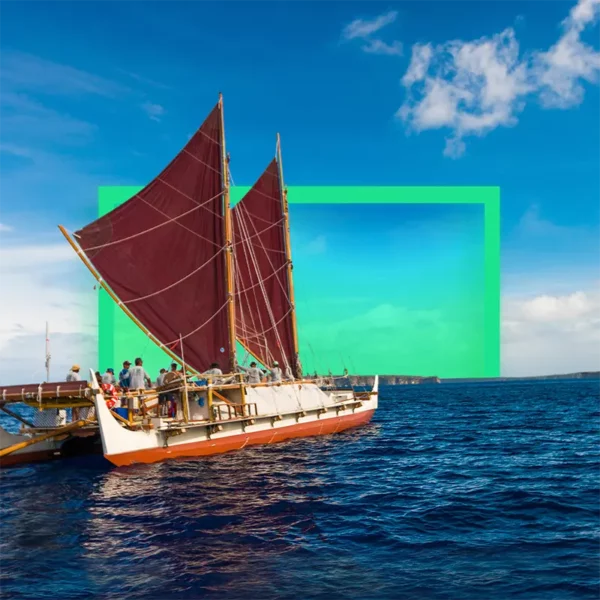
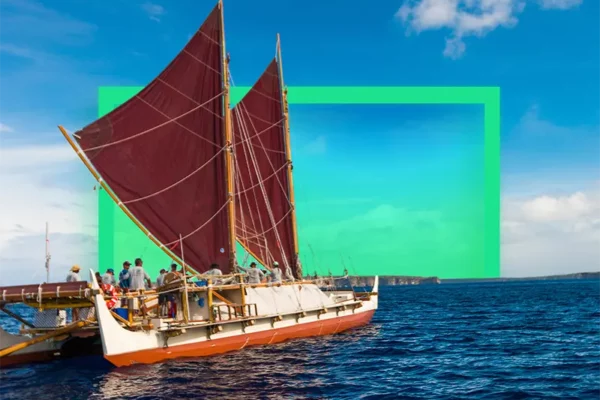
Table of Contents:
Transcript:
Tracking the path of the sun
LEHUA KAMALU: Our double-hulled canoe is built to the same specifications as the ones our ancestors sailed. To the modern eye it resembles a catamaran – a big floating room, 72-feet long and 24-feet wide, with no walls and no roof, nothing to protect you from the wind and the water and the waves and the sun.
I stay on the very edges of the canoe, nothing but a single railing to protect me from falling over the side. Because I want to be able to feel the wind. I want to be able to feel what’s going on beneath it.
ROHAN GUNATILLAKE: Lehua Kamalu captains a vast, double-hulled ocean canoe that is crafted to the precise specifications of the seafaring vessels used by her ancestors. She navigates a small crew across the same 2,500-mile journey between Tahiti and Hawaii that the original settlers of the South Pacific traversed. It’s a crossing that some historians once struggled to believe possible without today’s technology. In today’s Meditative Story, try to completely let go. And using the theater of your mind, take the journey with Lehua.
In this series, we blend immersive, first-person stories with mindfulness prompts to give you a deep sense of wellbeing at any time of the day. From WaitWhat and Thrive Global, this is Meditative Story. I’m Rohan, and I’ll be your guide.
The body relaxed. The body breathing. Your senses open. Your mind open. Meeting the world.
KAMALU: There is an old saying that seasoned voyagers share as they prepare to head out to sea: “You don’t know where you are unless you know where you’ve come from.”
I have my back to the sea, my gaze fixed on the lagoon as we set out to sail from Papeete Harbor in Tahiti, the crew casting off the lines that tether us to land. That little piece of ancient wisdom nourishes me as we move deeper into the ocean on our journey.
On shore, the crew’s families and friends gather alongside local Tahitians to celebrate our push-off. Men and women of all ages are singing and chanting from the dock, waving to us, taking photos. Many are wearing colorful leis, like the ones they placed on us during the Ava Ceremony this morning. This ceremony honors the journeys our ancestors each took to bring us to our islands, and to this moment. And gives each of the crew a space to set their intentions for the voyage ahead.
I’ve been voyaging for seven years. And when I am not at sea, I’m preparing. Morning, noon, and night – weekends and afternoons. It’s all-consuming.
I am focused now on the island we depart from, and the weather. The island is my reference point. I use it to orient our vessel on the map I’m drawing in my mind, to chart our course from here to Hawaii 2,500 nautical miles ahead of us. I watch the steady wind push through the grassy hills surrounding the harbor.
It’s a truly spectacular day, both windy and sunny, what we call a typical trade wind day. In conditions like this there aren’t really any waves, only great winds, so we can just glide along and be dry.
Our double-hulled canoe is built to the same specifications as the ones our ancestors sailed. To the modern eye it resembles a catamaran – a big floating room, 72-feet long and 24-feet wide, with no walls and no roof, nothing to protect you from the wind and the water and the waves.
I stay on the very edges of the canoe, nothing but a single railing to protect me from falling over the side. Because I want to be able to feel the wind. I want to be able to feel what’s going on beneath it.
Today is day 1 of the 17-day voyage. A voyage so long and technically complex that some historians had questioned it as our origin story. To them it was unthinkable. But we know what our ancestors were capable of. And we honor their achievement by employing the same traditional Polynesian wayfaring techniques they used generations ago.
I track the path of the sun and calculate the altitude of each star on the horizon, attune myself to the motion of waves that sway the boat as I stand on deck, observe and record the flight patterns of birds, the shapes of clouds, tracking their speed as they traverse the sky overhead. It’s a lost art. I’ve trained for years to revive this part of our history.
GUNATILLAKE: Let’s stand with Lehua here on the deck. Feel the movement of the sea underneath your feet. The birds, the wind, the vastness all around. Notice Lehua’s attention, steady. Acting from her history. What do you feel?
KAMALU: My crew members are from Tahiti, French Polynesia, the Tuamotus, Marquesas – we even have a young woman from Samoa. We range in age from 19 to 62. 5 women and 8 men. Not everyone on board speaks English, and many of us are sailing together for the first time. But we all understand what some people call te reo moana – the voice of the ocean. It binds us together. We find ways to communicate. Gestures and nods, looks in the eye that speak volumes.
We have a sailmaster ready to repair any damage, a watch captain, a medical officer, a carpenter, and a fisherman. And of course we have our apprentice navigator, who shadows me, ready to step in if I take ill or fall overboard and get lost at sea. Each member of the team attends his own station but we all come together as a fluid unit.
By 6 a.m. the sun rises, a burst of vibrant color rippling over the surface of the water, thin, electric fingers of yellow and pink simultaneously reaching toward the canoe and grasping at the sky.
Our fisherman Matahi has been up since 3 a.m. With him is Matatini from the island of Rangiroa. Matahi has run a hand line off of the back of the vessel, trailing in the water. There is no pole. It is attached by a rubber band to the back of the canoe. When we hear the band snap, we know something’s on the line.
A commotion breaks out. Within the blink of an eye they get there, handing off the paddle to another steersman. Matahi is about 5’6, he’s muscular. He’s a carver, an artist and a dancer, his movements appear effortless. He reels in the line, one hand over the other. In mere seconds Matatini leans over with a gaff and pulls up a glistening Ahi tuna with one arm, as if he’s done nothing more strenuous than tie his shoe. I have never seen a fish caught more efficiently.
Immediately, they get down to the business of cleaning it and prepping it. The catch is massive, it’ll feed us for days.
After dinner I debrief everyone about the day’s voyage and what to expect for the night ahead of us. I am thorough and direct. I don’t keep anything from the crew, full transparency. Each step of the way I explain what the game plan is for the different sections of the ocean that we will travel across.
This is the most communication I’ve engaged in all day long. From the outside looking in, you might think I don’t really do anything. Physically I’m not doing a lot of work. I’m not opening sails, closing sails, or steering. I’m thinking, and tracking, and conserving all my energy and focus for what the journey requires. I don’t have a “watch” per se, since I am always on watch. I stare out over the waves for hours and hours, trying to pick up on subtle changes in the wind and atmosphere.
GUNATILLAKE: Let your attention be like Lehua’s. Open, expanded, relaxed, sensitive. Picking up on subtle changes. Notice what is happening around you.
KAMALU: The waves rising up to meet me might seem like they’re only just arriving, but they began their journey across the water hundreds, if not thousands, of miles away. Just as we on this vessel have, through generations, stories, studies.
Seven days into our journey, we hit the doldrums, the deadening calm that you find often at the equator. The wind and water are completely still. We are powerless. The boat is being pulled at the mercy of the prevailing current. Clouds cover the stars. It is an eerie feeling.
On the 8th day of the trip – and our second day in the doldrums – the weather begins to fluctuate. One hour, it’s totally flat. The next hour, a light wind from the East puffs across the boat, brushing my face. My hair lifts gently in the breeze, falling upon my shoulders, and then lifts again. It’s heartening. Then, just one hour later, there’s a hammering wind coming straight down on us, and a downpour. I can feel the water cascading in continuous streams from my head to my feet. It continues to fall heavy on my body.
The winds swirl around us, coming from all directions at once. I anchor my feet on the deck and grip the slick railing with my hands. Layers of low-flying, dark clouds obscure my vision, so thick that the sun can’t shine through at all. It’s pitch black. At this point, we can’t even see the waves. But we can feel them.
The waves are not the long rolling waves we normally find at sea. We can ride those waves up and down, bobbing over their crests and troughs. But the wind and the waves here are condensed. What we’re getting is just wall, after wall, after wall, after wall of water. I feel the force of each wave as it punches the side of our canoe, a rhythmic pounding “Boom! Boom! Boom!”
We cannot hold a course with waves like these hitting us. They force us in a direction we don’t want to go. I’m pushed further and further from this mental route that I have mapped. I feel defenseless and exposed. The raw force of it is humbling.
But right now I can’t afford to miss a sign.
It’s the 12th day of the trip and the fifth day of darkness. I’m looking, specifically, for the sunset. Because if I can pinpoint one direction on my compass then I know exactly where I am. I just need that one point.
Finally, all of a sudden, the sun penetrates the clouds for just a moment, one pinprick of diffuse red light. We decide to call it the dragon’s eye. Knowing now, in this flicker of an instant, where the setting sun meets the sea, I can orient the vessel in space. Morale spikes and I see a communal relief in the faces of the crew.
We’re too far west, so I hone in on my target: Hawaii, east side of the Big Island. I see Ursa Major, Minor, the Big Dipper, the Little Dipper. We’ve held patiently in these uncertain waters, and I know for certain once again that I’m on the right path. I just need to stay true to it. And if I do, it will take us where we mean to be.
Before we even sight the island, we can see a fiery glow of lava flowing into the ocean. And then the island appears. The sun begins to rise. We see the steam from the water as the lava pours in.
Hawaii. We’ve arrived.
GUNATILLAKE: They have arrived. Bodies, minds together and at their destination. Where are you? Is your mind here or is it elsewhere? If you’re distracted at all, can you arrive now too?
KAMALU: I have been mostly stone-faced for 17 days, but as we pull in from our voyage to the Big Island, I weep. What should feel like an arrival oddly feels like a departure. The crew cheers, exalted. But even before we arrive I’m already missing them.
I have long felt there is a lot of time left ahead of me. Now I feel myself getting older, leaving more and more behind me.
As we approach the island, I realize that maybe all this time I’ve been running towards something, rather than away, seeking a better understanding of myself. On these voyages I am challenged to reflect on why I am the way I am.
On the canoe, my purpose is clearly defined. I understand exactly what my role is. I know where I stand. I have seen the glows of happiness in the faces of my crew – and have felt it myself – when we come together in the service of a single goal.
It has been difficult for me to experience that sense of orientation in my life at home. To my family, my friends, my history.
Packing up to leave the vessel, my home for these past 17 days, mundane thoughts begin to creep in: “When should I head to the airport? Do I have any important emails? What will I have for dinner?”
I want more than anything to sustain the electric feeling I have out on the water, that sense of presence and attention. Of self-possession and control, of freedom and agility. How, I wonder, will I orient myself on land? How will I spot the stars, when the sky seems so much smaller from land than it does at sea?`
Hours later, on my flight home, I begin to drift off to a real sleep for the first time in what feels like ages, and as we penetrate the clouds and emerge into the clear, sun-filled sky, I remind myself that those stars are always there – they will always be there – as they are right now, even when I can’t see them.
Rohan’s closing meditation
GUNATILLAKE: I know that feeling Lehua talks about. The wish to sustain the feeling she had out on the water when she goes back onto land. As a young man I spent a lot of time on meditation retreats and it was always the question that came up for me as they came to an end – how to keep the calm, the balance, the bliss even as I moved back into my city life.
After struggling several times, I realized it was the wrong question. Long meditation retreats, the nature of voyages, such as Lehua’s, are unique environments and when the things that hold those experiences up – the silence, the vastness, the connectedness with others, the connectedness with nature – when they are no longer there, of course it is going to be different.
A better question therefore might be, “how do I accept where I am and stay in touch with the magical here, without wanting my environment to be different?” And it’s a question that feels very alive given the global situation we’re all in at the moment, where movement is limited. But does it mean that the qualities of the heart have to be as well? That’s what we’ll explore in our short meditation together. So sit, lie, comfortably. Whatever you’re doing, however your body is, notice any tension kicking around and let that recognition do its work, softening, relaxing, letting go.
The first thing we’re going to do together is remember a place where you feel most connected with the world around you. For Lehua it’s the open sea. What comes to mind for you? For me, it’s the hills in the West of Scotland, the lochs below, the land majestic. Big skies. What place or space do you first think of as a place of connection and peace. Bring it to mind. However makes sense to you.
How is your body as you remember? Remember. Reconnect with that place. That memory in the body, that openness in the body. Always accessible, even here, even when we feel confined.
Now bring to mind a person. Someone who for you symbolizes wisdom and connection. It could be someone quite young like Lehua or maybe your wise person has more years under their belt. See them, visualize them, sense them standing. How is their posture? Can you mirror how their body is? Can you mirror their strength, their love, their kindness? That memory in you. Your wise being. Always accessible. Even here, when we feel constricted.
And just as Lehua and her crew had to move through the storm, the rain, the darkness – being gentle on yourself and only if you feel ok to do so, can you bring to mind a time when you had to deal with the difficult – which at the time felt so overwhelming – but you got through. Remember that time. See, sense yourself at that time. See your strength, your skill, your wisdom.
And sensing that like Lehua senses the waves and the stars, in this difficult time let yourself in that moment energize and inform yourself in this one. Let your body mirror your strength like the sea mirrors the sky. Remember with your body and let that memory be the pinprick of sun with the power to diffuse the darkness.
Thank you, Lehua.
And thank you.
